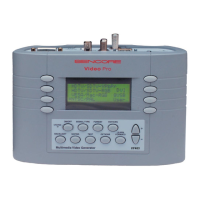VP400 Series Video Pro Form7343A Operation Manual
57
Appendix E: Applying SDI/HDSDI Signals
(SH VideoPro Option)
Serial Digital Interface (SDI) and High Definition Serial Digital Interface (HDSDI) are serial
digital interface signals. These signals originated as a means to interface uncompressed,
unencrypted digitized video between devices in the television production and broadcast
environments. In recent years, SDI and HDSDI are beginning to branch out into other
applications and more and more displays are being designed with SDI and HDSDI inputs.
Figure 1. Serial Digital Interface video
signals are found in TV production &
broadcast, signage, cinema, rental &
staging, and increasingly more and more
applications.
Serial Digital Interface Signal
A serial digital video signal is produced using the video’s Y, Cr, and Cb component voltages
representing the luminance and color picture information. These individual component voltages
are input to ADC (analog-to-digital converters).The converters take samples, snapshots in time,
of the voltage levels occurring on the Y, Cr and Cb inputs. The snapshot voltages are quantified
into 10 bit digital values representing levels from black to white (luminance) and color levels
(Cr, Cb).
The clock sampling rates for the conversion is chosen to be multiples of the color sub-carrier
frequency. For example, the SDI 525i system samples the luminance at 13.5 MHz and the Cb
and Cr at ½ this rate or 6.75MHz. Therefore, for every 4 luminance samples there are two Cb
and Cr samples. This is stated as a 4:2:2 digital sampling ratio.
Imagine a picture frame feeding the Y, Cr, Cb ADC sequentially video line by line. The resulting
output of each ADC is sequential 10 bit digital words (digital samples) representing Y, Cr and
Cb for the entire picture frame. These digital values are multiplexed together so they can exist on
a single cable and then be separated by the receiver. The output of the time division multiplexer
is multiplexed data words Y, Cr, Y, Cb, etc.
Synchronizing bits are added to the digital multiplexed signal and encoding is applied.
Synchronizing bits and encoding enables the serial digital receiver to properly detect the
beginning of the picture frame and horizontal blanking times to recover the Y, Cr and Cb
components.

